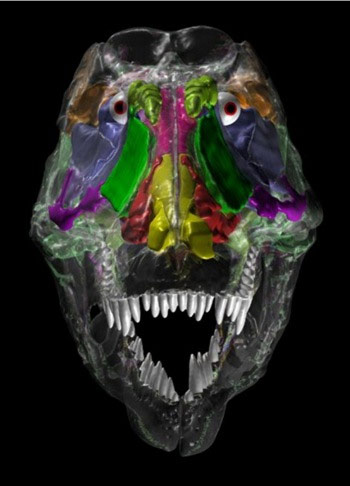Dinosaurs Were Airheads

The noggins of fierce dinosaurs like T. rex were filled with … air. The airy skulls would have lightened the load of the head and possibly acted as resonating chambers for communication among some of the dinosaurs, new research reveals.
"We always knew dinosaurs had relatively small brains, so we might regard them as being airheads, and we can see that's kind of literally true," said researcher Lawrence Witmer of Ohio University.
The new finding adds to research by Witmer and his colleagues in which they found the air spaces in the skulls of duck-billed dinosaurs helped the animals to vocalize, possibly giving each of them distinct "voices."
Light-headed
Witmer and Ohio University colleague Ryan Ridgely used computed tomography to scan the skulls of two predatory dinosaurs, Tyrannosaurus rex and Majungasaurus, as well as two ankylosaurian dinosaurs, Panoplosaurus and Euoplocephalus — both plant-eaters with armored bodies and short snouts.
The resulting 3-D images revealed large olfactory areas, a curving airway that extended from the nostrils to the throat and several sinus cavities (similar to the pockets that give us sinus headaches). And overall, the amount of air-filled space was much greater than the brain cavity.
The air spaces probably helped to lighten the load of the T. rex's head, making it about 18 percent lighter than if the head were a solid structure. They estimated a fully fleshed-out T. rex head likely weighed more than 1,100 pounds (500 kg), while the skull of Majungasaurus would have weighed 70 pounds (32 kg). (If T. rex's skull would have been solid bone, it would have weighed a couple hundred pounds more.)
Sign up for the Live Science daily newsletter now
Get the world’s most fascinating discoveries delivered straight to your inbox.
Neck muscles and other body features could only hold up so much head heft. So if all the other features remained the same, the weight savings from having the air-filled pockets may have allowed T. rex and Majungasaurus to sport other hefty skull features, such as more bone-crushing jaw muscles or the ability to take down larger prey.
Like hollow beams used in construction, the sinus cavities would have inflated the bones to make them ultra strong yet still relatively light. With light, strong heads, these dinosaurs would have been able to whip their heads around more quickly.
Dino voices
The armored dinosaurs were a different story. Unlike the somewhat straight nasal passages found in the predatory dinos, the researchers found airways that were twisted and convoluted, kind of like crazy straws, Witmer said.
The winding passages were positioned alongside large blood vessels, they found, suggesting heat transfer. So when the armored dinosaurs inhaled, the blood would have warmed that inspired air before it reached the lungs. In addition, some of the heat from the blood vessels may have been transferred into the winding nasal passages, cooling the blood before it reached the brain.
"These were large-bodied animals generating a lot of heat in their bellies," Witmer told LiveScience.
The twisty nasal passages also probably acted as resonating chambers, affecting how the ankylosaurs vocalized. The airways may have been slightly different in each animal, Witmer said, giving the animals subtle differences in their voices.
The findings are published in a recent issue of the journal The Anatomical Record.
- A Brief History of Dinosaurs
- Avian Ancestors: Dinosaurs That Learned to Fly
- Images: Dinosaur Fossils
Jeanna Bryner is managing editor of Scientific American. Previously she was editor in chief of Live Science and, prior to that, an editor at Scholastic's Science World magazine. Bryner has an English degree from Salisbury University, a master's degree in biogeochemistry and environmental sciences from the University of Maryland and a graduate science journalism degree from New York University. She has worked as a biologist in Florida, where she monitored wetlands and did field surveys for endangered species, including the gorgeous Florida Scrub Jay. She also received an ocean sciences journalism fellowship from the Woods Hole Oceanographic Institution. She is a firm believer that science is for everyone and that just about everything can be viewed through the lens of science.










